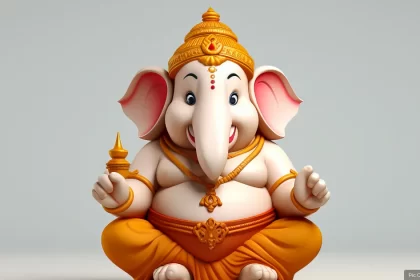Last Updated 2 weeks ago
Ancient Temples in India – India is home to thousands of temples, each with its unique architectural style, religious significance, and cultural heritage. Temples play a central role in the spiritual and social life of the Indian people, serving as places of worship, pilgrimage, and community gatherings. Here are some key points about temples in India –
- Religious Diversity – India is a land of religious diversity, with temples dedicated to various deities from Hinduism, Buddhism, Jainism, Sikhism, and other faiths. Each temple reflects the religious beliefs and practices of its devotees.
- Architectural Marvels – Indian temples showcase a wide range of architectural styles, including Dravidian, Nagara, Vesara, and Indo-Islamic. They feature intricately carved sculptures, towering gopurams (gateway towers), mandapams (pillared halls), and ornate shrines.
- Pilgrimage Centers – Many temples in India are revered as sacred pilgrimage centers, drawing millions of devotees and tourists each year. Pilgrimage routes, known as tirthas or yatras, connect these temples and are an integral part of India’s religious tradition.
- Historical Significance – Temples in India often have rich historical and mythological backgrounds, with legends and stories associated with their origins. Some temples are mentioned in ancient texts such as the Puranas, Mahabharata, and Ramayana.
- Festivals and Rituals – Temples are the focal points of religious festivals and rituals, which are celebrated with great fervor and enthusiasm throughout the year. Festivals such as Diwali, Navratri, and Maha Shivaratri are observed with elaborate rituals, processions, and cultural events.
- Community Service – Temples play a significant role in community service and philanthropy, providing food, shelter, healthcare, and education to the needy. They also serve as centers for cultural and educational activities, including music, dance, and scripture recitation.
- Conservation and Preservation – Many temples in India are ancient structures that require conservation and preservation efforts to protect them from natural disasters, environmental degradation, and human encroachment. Government agencies, religious organizations, and heritage conservation groups work together to safeguard these architectural treasures.
- Spiritual Tourism – Temples are major attractions for spiritual tourism in India, attracting visitors from within the country and abroad. Tourist infrastructure such as accommodations, transportation, and guides are often available near popular temple sites to cater to the needs of pilgrims and tourists.
Overall, temples in India are not just places of worship but also symbols of the country’s rich cultural and spiritual heritage, reflecting the devotion and faith of its people across generations.
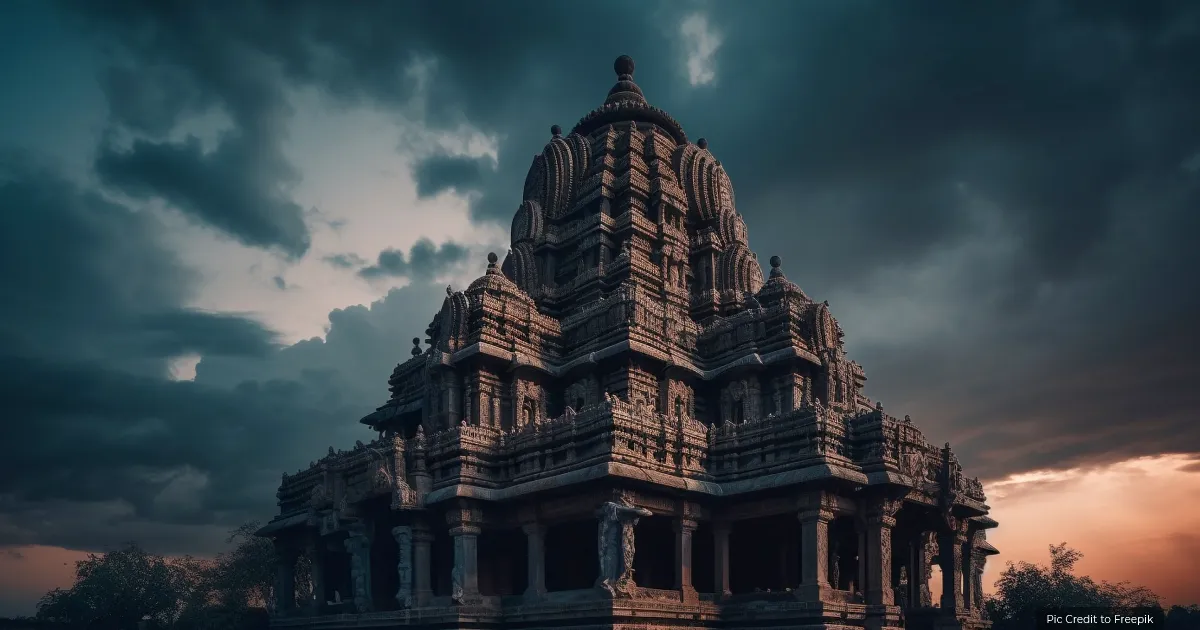
List of 100+ Most Ancient Temples in India [State wise]
Andhra Pradesh
- Sri Kalahasti Temple, Andhra Pradesh
- Tirumala Venkateswara Temple, Tirupati, Andhra Pradesh
Assam
- Kamakhya Temple, Guwahati, Assam
Bihar
- Mahabodhi Temple, Bodh Gaya, Bihar
- Vishnupad Temple, Gaya, Bihar
Delhi
- Akshardham Temple, Delhi
- Laxminarayan Temple, Delhi
- Shri Hanuman Mandir, Connaught Place, Delhi
Goa
- Mahalasa Narayani Temple, Goa
- Saptakoteshwar Temple, Goa
- Shree Mangueshi Temple, Goa
Gujarat
- Akshardham Temple, Gandhinagar, Gujarat
- Dwarkadhish Temple, Dwarka, Gujarat
- Nageshwar Jyotirlinga, Dwarka, Gujarat
- Somnath Temple, Somnath, Gujarat
- Shamlaji Temple, Samalaji, Gujarat
- Shree Mahakali Mataji Temple, Pavagadh, Gujarat
Himachal Pradesh
- Chamunda Devi Temple, Kangra, Himachal Pradesh
Jammu and Kashmir
- Amarnath Temple, Jammu and Kashmir
- Martand Sun Temple, Jammu and Kashmir
- Shri Raghunath Temple, Jammu and Kashmir
- Vaishno Devi Temple, Katra, Jammu and Kashmir
Karnataka
- Chamundeshwari Temple, Mysore, Karnataka
- Chennakesava Temple, Belur, Karnataka
- Hoysaleswara Temple, Halebidu, Karnataka
- Mahabaleshwar Temple, Gokarna, Karnataka
- Virupaksha Temple, Hampi, Karnataka
- Vittala Temple, Hampi, Karnataka
- Yoganarasimha Swamy Temple, Melukote, Karnataka
Kerala
- Guruvayur Temple, Guruvayur, Kerala
- Sabarimala Ayyappa Temple, Kerala
- Sree Padmanabhaswamy Temple, Thiruvananthapuram, Kerala
- Sreekanteswara Temple, Kozhikode, Kerala
- Vaikom Mahadeva Temple, Kerala
Madhya Pradesh
- Chausath Yogini Temple, Morena, Madhya Pradesh
- Kandariya Mahadeva Temple, Khajuraho, Madhya Pradesh
- Sanchi Stupa, Sanchi, Madhya Pradesh
- Shri Mahakaleshwar Temple, Ujjain, Madhya Pradesh
Maharashtra
- Babulnath Temple, Mumbai, Maharashtra
- Grishneshwar Temple, Verul, Maharashtra
- Kailash Temple, Verul, Maharashtra
- Mahalakshmi Temple, Kolhapur, Maharashtra
- Pandharpur Vitthal Temple, Maharashtra
- Parvati Temple, Pune, Maharashtra
- Shirdi Sai Baba Temple, Maharashtra
- Shree Siddhivinayak Temple, Mumbai, Maharashtra
- Shri Bhimashankar Temple, Maharashtra
- Shri Kalaram Sansthan Mandir, Maharashtra
- Siddheshwar Temple, Solapur, Maharashtra
- Tulja Bhavani Temple, Maharashtra
Odisha
- Konark Sun Temple, Konark, Odisha
- Lingaraj Temple, Bhubaneswar, Odisha
- Rajarani Temple, Bhubaneswar, Odisha
- Shree Jagannath Temple, Puri, Odisha
Punjab
- Golden Temple Sri Harmandir Sahib, Amritsar, Punjab
Rajasthan
- Dilwara Temples, Mount Abu, Rajasthan
- Eklingji Temple, Rajasthan
- Jagat Shiromani Temple, Amer, Rajasthan
- Jaisalmer Jain Temple, Jaisalmer, Rajasthan
- Karni Mata Temple, Deshnoke, Rajasthan
- Ranakpur Jain Temple, Ranakpur, Rajasthan
- Shri Mahavir Ji Temple, Rajasthan
- Shri Mehandipur Balaji Temple, Dausa, Rajasthan
Tamil Nadu
- Adi Kumbeswarar Temple, Kumbakonam, Tamil Nadu
- Arulmigu Nellaiappar Temple, Tirunelveli, Tamil Nadu
- Brihadeeswara Temple, Gangaikonda Cholapuram, Tamil Nadu
- Chidambaram Temple, Chidambaram, Tamil Nadu
- Ekambareswarar Temple, Kanchipuram, Tamil Nadu
- Jambukeswarar Temple, Tiruchirappalli, Tamil Nadu
- Kailasanathar Temple, Kanchipuram, Tamil Nadu
- Kailasanathar Temple, Thingalur, Tamil Nadu
- Mahabalipuram Shore Temple, Mahabalipuram, Tamil Nadu
- Meenakshi Amman Temple, Madurai, Tamil Nadu
- Ramanathaswamy Temple, Rameswaram, Tamil Nadu
- Ranganathaswamy Temple, Srirangam, Tamil Nadu
- Thanumalayan Temple, Suchindram, Tamil Nadu
- Thillai Nataraja Temple, Chidambaram, Tamil Nadu
- Vaitheeswaran Temple, Vaitheeswarankoil, Tamil Nadu
- Arunachaleswarar Temple, Tamil Nadu
- Chola Temples, Tamil Nadu
- Brihadeeswara Temple, Thanjavur, Tamil Nadu
- Gangaikonda Cholapuram Temple, Tamil Nadu
- Dharasuram Airavatesvara Temple, Tamil Nadu
- Vijayalaya Choleeswaram, Naarthaamalai, Tamil Nadu
- Shri Balasubrahmanya Swami Temple, Tamil Nadu
- Nageswaran Temple, Tamil Nadu
- Moovar Koil Temple, Tamil Nadu
- Koranganatha Swamy Temple, Tamil Nadu
- Valisvara Temple, Tamil Nadu
- Kampaheswarar Temple, Thirubuvanam, Tamil Nadu
Telangana
- Ramappa Temple, Palampet, Telangana
Rajasthan
- Banke Bihari Temple, Vrindavan, Uttar Pradesh
- Kashi Vishwanath Temple, Varanasi, Uttar Pradesh
- Vrindavan Chandrodaya Mandir, Mathura, Uttar Pradesh
Uttarakhand
- Badrinath Temple, Badrinath, Uttarakhand
- Gangotri Temple, Gangotri, Uttarakhand
- Kedarnath Temple, Kedarnath, Uttarakhand
- Nanda Devi Mandir, Almora, Uttarakhand
- Tungnath Temple, Uttarakhand
- Yamunotri Temple, Yamunotri, Uttarakhand
Uttarakhand
- Dakshineswar Temple, Kolkata, West Bengal
- Kalighat Kali Temple, Kolkata, West Bengal
- Parasnath Jain Temple, Kolkata, West Bengal
Details of 15 of the Most Ancient Temples in India
Brihadeeswarar Temple, Thanjavur, Tamil Nadu

The Brihadeeswarar Temple, also known as the Big Temple, is a Hindu temple dedicated to Lord Shiva located in Thanjavur, Tamil Nadu, India. In the race for the top 100+ most ancient temples in India, The Brihadeeswarar Temple, Thanjavur, Tamil Nadu stands at the 1st position. Here are some details about this iconic temple
- Location – The Brihadeeswarar Temple is situated in the city of Thanjavur, which was formerly known as Tanjore. It is located in the southern part of Tamil Nadu, in the Chola Nadu region.
- History – The temple was built by the Chola king Raja Raja Chola I in the 11th century AD. It was completed in 1010 AD and is considered one of the greatest architectural achievements of the Chola dynasty. The temple is a UNESCO World Heritage Site and is renowned for its architectural grandeur and cultural significance.
- Architectural Style – The Brihadeeswarar Temple is a prime example of Dravidian architecture, characterized by its towering gopurams (gateway towers), intricately carved pillars, and sculptures depicting various deities and mythological figures. The temple is constructed entirely of granite, with the main temple tower (vimana) soaring to a height of 216 feet, making it one of the tallest temple towers in the world.
- Main Deity – The primary deity of the Brihadeeswarar Temple is Lord Shiva, worshipped in the form of a lingam (symbol of Shiva). The sanctum sanctorum (garbhagriha) houses the lingam, which is believed to be a self-manifested (swayambhu) representation of Lord Shiva.
- Nandi Mandapam – In front of the main shrine stands a large Nandi (bull) sculpture, the sacred vehicle of Lord Shiva. The Nandi mandapam (pavilion) is intricately carved and serves as a prominent feature of the temple complex.
- Festivals – The Brihadeeswarar Temple celebrates various festivals throughout the year, with Mahashivaratri being the most significant. During festivals, the temple comes alive with colorful processions, music, dance, and rituals performed by priests and devotees.
- Visitor Information – The Brihadeeswarar Temple is open to visitors and devotees every day, with specific timings for darshan (viewing of the deity) and worship. Visitors are required to adhere to the temple’s dress code and follow the prescribed guidelines for entry and participation in rituals.
- Conservation – The temple complex is under the stewardship of the Archaeological Survey of India (ASI), which oversees its preservation, maintenance, and restoration efforts. Conservation work is periodically carried out to safeguard the temple’s architectural heritage for future generations.
The Brihadeeswarar Temple stands as a testament to the rich cultural and architectural legacy of ancient India and continues to be a source of spiritual inspiration and awe for visitors from around the world.
Kailasanathar Temple, Kanchipuram, Tamil Nadu
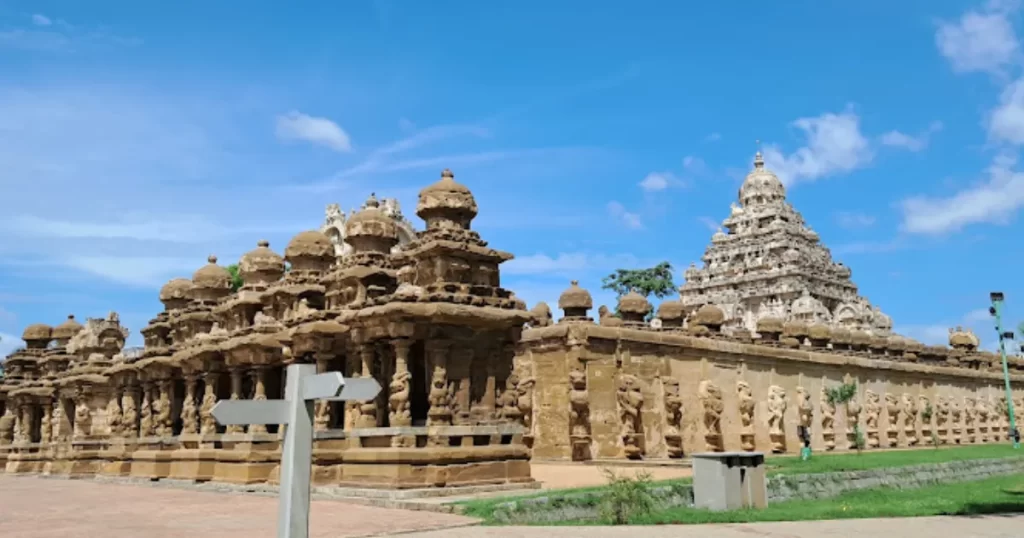
The Kailasanathar Temple is an ancient Hindu temple dedicated to Lord Shiva located in Kanchipuram, Tamil Nadu, India. In the race for the top 100+ most ancient temples in India, The Kailasanathar Temple, Kanchipuram, Tamil Nadu stands at the 2nd position. Here are some details about this historic temple
- Location – The Kailasanathar Temple is situated in the town of Kanchipuram, also known as the “City of Thousand Temples.” Kanchipuram is located about 70 kilometers southwest of Chennai, the capital city of Tamil Nadu.
- History – The temple was built in the 8th century AD during the reign of the Pallava dynasty, making it one of the oldest temples in Kanchipuram. It is believed to have been constructed by King Rajasimha (also known as Narasimhavarman II) to commemorate his victory over the Chalukyas.
- Architectural Style – The Kailasanathar Temple is a classic example of Dravidian architecture, characterized by its pyramidal tower (vimana), pillared halls (mandapams), and intricately carved sculptures. The temple showcases various architectural elements such as gopurams (gateway towers), niches, and relief sculptures depicting scenes from Hindu mythology and legends.
- Main Deity – The primary deity of the temple is Lord Shiva, worshipped in the form of a lingam (symbol of Shiva) in the sanctum sanctorum (garbhagriha). The temple complex also houses shrines dedicated to other deities such as Parvati, Ganesha, and Kartikeya.
- Structural Features – The main shrine of the Kailasanathar Temple is surrounded by a circumambulatory path (pradakshina patha) and enclosures (prakarams) containing smaller shrines, mandapams, and subsidiary structures. The temple complex is known for its tranquil ambiance and spiritual atmosphere.
- Sculptural Marvels – The temple is renowned for its exquisite stone carvings and sculptures, which adorn its walls, pillars, and ceilings. The intricate carvings depict various deities, celestial beings, mythical creatures, and scenes from Hindu epics such as the Ramayana and Mahabharata.
- Festivals – The Kailasanathar Temple celebrates various Hindu festivals throughout the year, including Maha Shivaratri, Panguni Uthiram, and Arudra Darshanam. These festivals attract devotees from across the region who gather to offer prayers and participate in religious rituals.
- Heritage Status – The Kailasanathar Temple is recognized as a protected monument under the Archaeological Survey of India (ASI) and is listed as a UNESCO World Heritage Site as part of the “Great Living Chola Temples” ensemble, which includes other temples in Tamil Nadu built by the Chola dynasty.
The Kailasanathar Temple stands as a testament to the architectural and artistic prowess of the Pallava dynasty and continues to be a revered pilgrimage site and cultural landmark in Kanchipuram.
Konark Sun Temple, Konark, Odisha

The Konark Sun Temple is a historic Hindu temple dedicated to the Sun God (Surya) located in Konark, Odisha, India. In the race for the top 100+ most ancient temples in India, The Konark Sun Temple, Konark, Odisha stands at the 3rd position. Here are some details about this magnificent temple
- Location – The Konark Sun Temple is situated in the town of Konark, approximately 35 kilometers northeast of Puri and 65 kilometers from the state capital, Bhubaneswar. It is located on the eastern coast of India, near the Bay of Bengal.
- History – The temple was built in the 13th century AD by King Narasimhadeva I of the Eastern Ganga Dynasty. It is believed to have been constructed between 1250 and 1264 AD. The temple was designed as a colossal chariot with 12 pairs of wheels, representing the chariot of the Sun God.
- Architectural Style – The Konark Sun Temple is a masterpiece of Odishan architecture and is renowned for its intricate carvings, monumental sculptures, and architectural grandeur. The temple is built in the Kalinga style of architecture, characterized by its pyramidal tower (vimana), mandapams (pillared halls), and sculpted walls depicting mythological themes.
- Main Deity – The primary deity of the Konark Sun Temple is the Sun God, Surya, depicted in a standing posture inside the main sanctum sanctorum (garbhagriha). The temple is designed such that the first rays of the morning sun illuminate the sanctum through the main entrance.
- Structural Features – The Konark Sun Temple is designed as a massive chariot with intricately carved stone wheels, horses, and other decorative elements. The temple complex also includes assembly halls, audience chambers, and subsidiary shrines dedicated to various deities.
- Sculptural Marvels – The temple is adorned with thousands of stone sculptures and carvings depicting celestial beings, mythical creatures, gods, goddesses, and scenes from Hindu epics such as the Mahabharata and Ramayana. The erotic sculptures on the temple walls are particularly famous for their artistic beauty and intricate detailing.
- Festivals – The Konark Sun Temple celebrates the annual Chandrabhaga Mela, a religious festival held during the Hindu month of Magha (January-February). The festival attracts thousands of pilgrims who gather to take holy dips in the Chandrabhaga River and offer prayers to the Sun God.
- Heritage Status – The Konark Sun Temple is recognized as a UNESCO World Heritage Site and is considered one of the Seven Wonders of India. It is also a protected monument under the care of the Archaeological Survey of India (ASI).
The Konark Sun Temple stands as a symbol of Odisha’s rich cultural heritage and architectural legacy, attracting tourists and pilgrims from around the world to witness its splendor and grandeur.
Jagannath Temple, Puri, Odisha

The Jagannath Temple is a famous Hindu temple dedicated to Lord Jagannath, a form of Lord Vishnu, located in Puri, Odisha, India. In the race for the top 100+ most ancient temples in India, The Jagannath Temple, Puri, Odisha stands at the 4th position. Here are some details about this revered temple
- Location – The Jagannath Temple is situated in the town of Puri, on the eastern coast of India, approximately 60 kilometers south of the state capital, Bhubaneswar. Puri is a significant pilgrimage destination and is known as one of the Char Dham pilgrimage sites.
- History – The temple has ancient origins and is believed to have been built by King Indradyumna, a legendary ruler of the region, in the 12th century AD. The temple has undergone several renovations and expansions over the centuries, with the current structure dating back to the 12th century.
- Architectural Style – The Jagannath Temple is built in the Kalinga style of architecture, characteristic of Odishan temples. The temple complex is surrounded by high walls and consists of several structures, including the main sanctum sanctorum (garbhagriha), assembly hall (mandapa), and pillared halls.
- Main Deity – The primary deities of the Jagannath Temple are Lord Jagannath (Krishna), his sister Subhadra, and his elder brother Balabhadra (Balarama). The deities are worshipped in the sanctum sanctorum, which is adorned with richly decorated altars and canopies.
- Rath Yatra – The Jagannath Temple is famous for its annual Rath Yatra or Chariot Festival, which attracts millions of devotees from across India and around the world. During the festival, the deities are placed on elaborately decorated chariots and pulled through the streets of Puri in a grand procession.
- Prasad and Offerings – The temple is known for its sacred food offerings, known as mahaprasad, which is offered to the deities and distributed to devotees as a form of divine blessing. The mahaprasad includes various dishes such as khichdi, dal, vegetables, sweets, and cakes.
- Temple Administration – The Jagannath Temple is managed by a body known as the Shree Jagannath Temple Administration (SJTA), which oversees the day-to-day operations, rituals, and festivals of the temple. The administration also maintains the temple complex and manages the affairs of the pilgrims.
- Heritage Status – The Jagannath Temple is one of the holiest and most visited temples in India and is recognized as a UNESCO World Heritage Site as part of the “Sun Temple, Konark and Puri’s Jagannath Temple” ensemble. It is also a protected monument under the Archaeological Survey of India (ASI).
The Jagannath Temple is not only a place of worship but also a symbol of Odisha’s rich cultural heritage and religious tradition, attracting devotees, pilgrims, and tourists from all walks of life.
Meenakshi Amman Temple, Madurai, Tamil Nadu
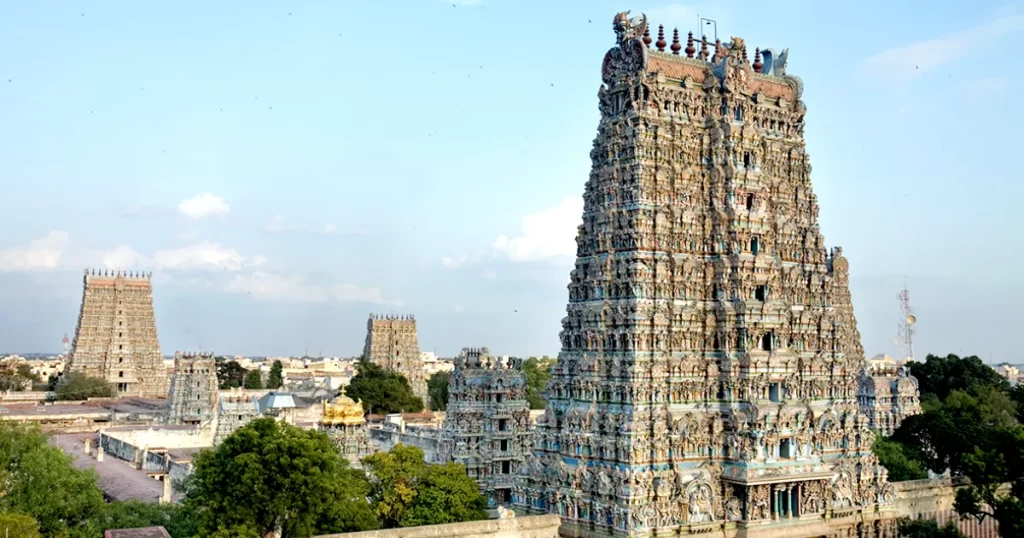
The Meenakshi Amman Temple is a historic Hindu temple dedicated to Goddess Meenakshi (Parvati) and her consort Lord Sundareswarar (Shiva) located in Madurai, Tamil Nadu, India. In the race for the top 100+ most ancient temples in India, The Meenakshi Amman Temple, Madurai, Tamil Nadu stands at the 5th position. Here are some details about this iconic temple
- Location – The Meenakshi Amman Temple is situated in the heart of Madurai, one of the oldest continuously inhabited cities in India. Madurai is located in the southern part of Tamil Nadu, approximately 450 kilometers southwest of Chennai, the state capital.
- History – The temple has ancient origins dating back over 2,000 years. It is believed to have been originally built by the Pandyan dynasty, although the current structure dates mostly from the Nayak dynasty (16th to 18th centuries). The temple has undergone several renovations and expansions over the centuries.
- Architectural Style – The Meenakshi Amman Temple is renowned for its Dravidian architecture, characterized by its towering gopurams (gateway towers), pillared halls (mandapams), and intricately carved sculptures. The temple complex covers an area of around 14 acres and is enclosed by high walls adorned with elaborate carvings.
- Main Deities – The primary deities of the Meenakshi Amman Temple are Goddess Meenakshi (Parvati) and Lord Sundareswarar (Shiva), who are enshrined in separate sanctums within the temple complex. The central shrine of Meenakshi features a golden image of the goddess adorned with jewelry and garlands.
- Sculptural Marvels – The temple is adorned with thousands of stone sculptures and carvings depicting gods, goddesses, celestial beings, and mythological scenes from Hindu epics such as the Ramayana and Mahabharata. The exquisite craftsmanship and intricate detailing of the sculptures are a testament to the skill of the artisans of ancient India.
- Golden Lotus Tank – The Meenakshi Amman Temple is known for its sacred tank, known as the “Potramarai Kulam” or Golden Lotus Tank, located within the temple complex. The tank is surrounded by colonnades and is used for ritual bathing and ceremonies.
- Festivals – The temple celebrates several festivals throughout the year, with the most significant being the Meenakshi Thirukalyanam, an annual celestial wedding ceremony of Goddess Meenakshi and Lord Sundareswarar. The festival attracts thousands of devotees who gather to witness the grand procession and rituals.
- Heritage Status – The Meenakshi Amman Temple is a UNESCO World Heritage Site and is recognized as one of the greatest architectural and artistic achievements of South India. It is also a protected monument under the care of the Archaeological Survey of India (ASI).
The Meenakshi Amman Temple is not only a place of worship but also a symbol of Madurai’s rich cultural heritage and religious tradition, attracting pilgrims, tourists, and art enthusiasts from around the world.
Badrinath Temple, Badrinath, Uttarakhand
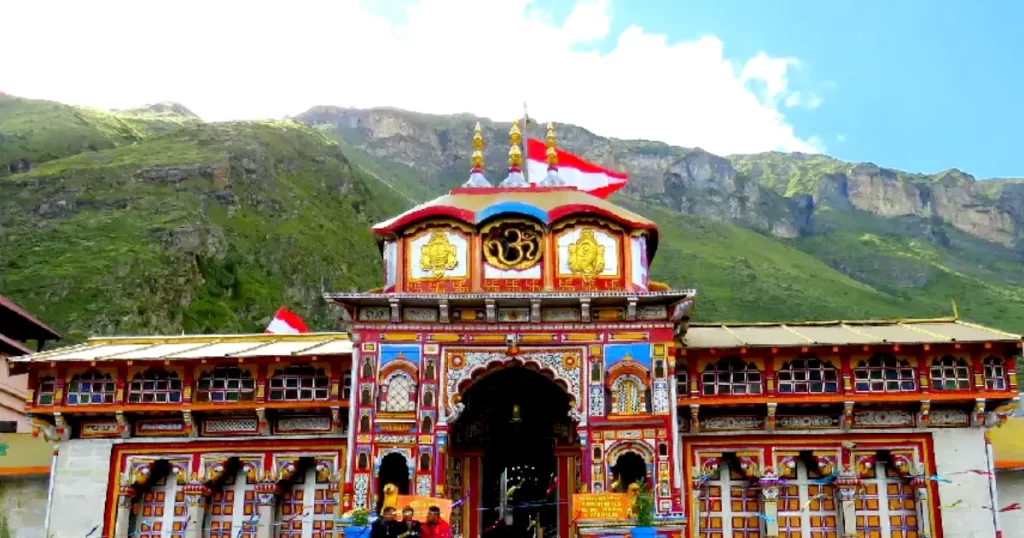
The Badrinath Temple is a revered Hindu temple dedicated to Lord Vishnu, located in the town of Badrinath in the Chamoli district of Uttarakhand, India. In the race for the top 100+ most ancient temples in India, The Badrinath Temple, Badrinath, Uttarakhand stands at the 6th position. Here are some details about this sacred temple
- Location – The Badrinath Temple is situated in the town of Badrinath, nestled amidst the picturesque Himalayan ranges along the banks of the Alaknanda River. It is located at an altitude of approximately 3,133 meters (10,279 feet) above sea level.
- History – The temple has ancient origins and is mentioned in various Hindu scriptures, including the Vishnu Purana and Skanda Purana. It is believed to have been established by the 8th-century philosopher and saint Adi Shankaracharya. The current structure of the temple dates back to the 16th century.
- Architectural Style – The Badrinath Temple is built in the traditional North Indian temple architecture style, characterized by its tall shikharas (spires), pillared mandapams (halls), and intricate stone carvings. The temple is constructed primarily of stone and stands as a symbol of devotion and craftsmanship.
- Main Deity – The primary deity of the Badrinath Temple is Lord Vishnu, worshipped in the form of a black stone idol known as Badri Vishal or Badrinarayan. The idol is enshrined in the sanctum sanctorum (garbhagriha) of the temple, which is adorned with gold and silver ornaments.
- Panch Badri – The Badrinath Temple is part of the Panch Badri pilgrimage circuit, which includes five sacred temples dedicated to Lord Vishnu. The other four temples in the circuit are Adi Badri, Vriddha Badri, Bhavishya Badri, and Yogadhyan Badri, each located in different parts of Uttarakhand.
- Pilgrimage Destination – The Badrinath Temple is one of the holiest pilgrimage sites for Hindus and is visited by thousands of devotees and tourists every year, especially during the summer months when the temple is open to the public. Pilgrims undertake the arduous journey to seek the blessings of Lord Vishnu and to attain spiritual liberation.
- Festivals – The temple celebrates various festivals throughout the year, with the most significant being the Badri Kedar Festival, which takes place during the months of May and June. The festival features colorful processions, devotional music, cultural performances, and rituals dedicated to Lord Vishnu and Lord Shiva.
- Heritage Status – The Badrinath Temple is a revered religious site and is protected as a UNESCO World Heritage Site. It is also a protected monument under the Archaeological Survey of India (ASI) and is managed by the Badrinath-Kedarnath Temple Committee.
The Badrinath Temple stands as a symbol of faith, devotion, and spiritual enlightenment, attracting devotees and seekers from all corners of the world to experience its divine presence and serene surroundings amidst the majestic Himalayas.
Kedarnath Temple, Kedarnath, Uttarakhand
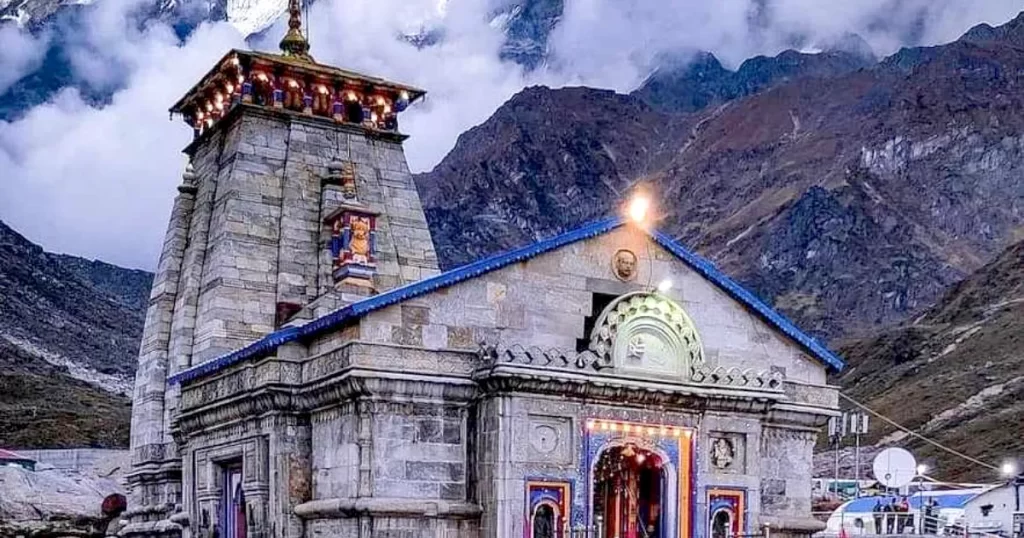
The Kedarnath Temple is a sacred Hindu temple dedicated to Lord Shiva, located in the town of Kedarnath in the Rudraprayag district of Uttarakhand, India. In the race for the top 100+ most ancient temples in India, The Kedarnath Temple, Kedarnath, Uttarakhand stands at the 7th position. Here are some details about this revered temple
- Location – The Kedarnath Temple is situated in the Garhwal Himalayas, nestled amidst the majestic peaks of the Kedarnath range. It is located at an altitude of approximately 3,583 meters (11,755 feet) above sea level, making it one of the highest temples in India.
- History – The temple has ancient origins and is mentioned in various Hindu scriptures, including the Mahabharata and the Skanda Purana. It is believed to have been established by the Pandavas, the legendary heroes of the Mahabharata, as a tribute to Lord Shiva. The current structure of the temple is believed to date back to the 8th century AD.
- Architectural Style – The Kedarnath Temple is built in the traditional North Indian temple architecture style, characterized by its stone walls, conical shikharas (spires), and pillared mandapams (halls). The temple is constructed using locally available grayish-white stones and stands as a testament to ancient craftsmanship.
- Main Deity – The primary deity of the Kedarnath Temple is Lord Shiva, worshipped in the form of a lingam (symbol of Shiva) enshrined in the sanctum sanctorum (garbhagriha) of the temple. The lingam is believed to be one of the 12 Jyotirlingas (sacred representations of Lord Shiva) and is highly revered by devotees.
- Pilgrimage Destination – The Kedarnath Temple is one of the holiest pilgrimage sites for Hindus and is part of the Chota Char Dham pilgrimage circuit, which also includes the Badrinath, Gangotri, and Yamunotri temples. Devotees undertake the arduous journey to Kedarnath to seek the blessings of Lord Shiva and to attain spiritual liberation.
- Accessibility – The temple is accessible by foot, pony, or helicopter from the town of Gaurikund, which serves as the base camp for the pilgrimage. The trek to Kedarnath from Gaurikund is approximately 16 kilometers long and passes through rugged terrain and scenic landscapes.
- Festivals – The temple celebrates various festivals throughout the year, with the most significant being the Maha Shivaratri festival, dedicated to Lord Shiva. The festival attracts thousands of devotees who gather to offer prayers, perform rituals, and participate in religious ceremonies.
- Heritage Status – The Kedarnath Temple is a revered religious site and is protected as a UNESCO World Heritage Site. It is also a protected monument under the Archaeological Survey of India (ASI) and is managed by the Kedarnath Temple Committee.
The Kedarnath Temple holds immense spiritual significance for Hindus and is revered as one of the most sacred pilgrimage sites in India. It attracts devotees and seekers from all over the world who come to experience the divine presence and serene ambiance of this ancient temple amidst the Himalayan mountains.
Somnath Temple, Somnath, Gujarat
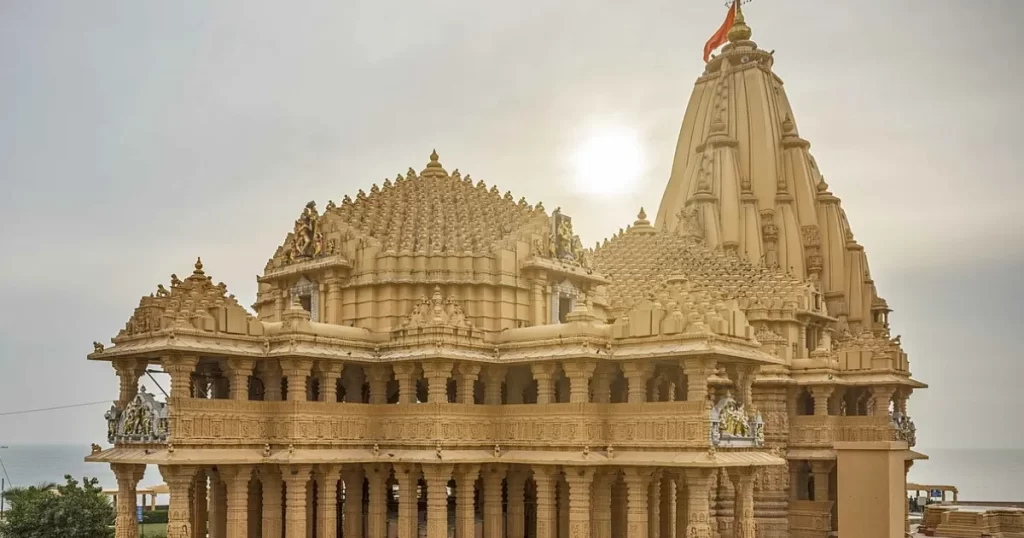
The Somnath Temple is a revered Hindu temple dedicated to Lord Shiva, located in the town of Somnath in the Gir Somnath district of Gujarat, India. In the race for the top 100+ most ancient temples in India, The Somnath Temple, Somnath, Gujarat stands at the 8th position. Here are some details about this historic temple
- Location – The Somnath Temple is situated on the western coast of Gujarat, overlooking the Arabian Sea. It is located in the town of Somnath, approximately 79 kilometers from the city of Junagadh and 25 kilometers from the city of Veraval.
- History – The temple has ancient origins and is believed to have been originally built by the Yadava kings of Vallabhi around the 5th century AD. It has been destroyed and reconstructed several times over the centuries due to invasions and natural disasters. The current structure of the temple dates back to the late 20th century.
- Architectural Style – The Somnath Temple is built in the traditional Hindu temple architecture style, characterized by its towering shikharas (spires), pillared mandapams (halls), and intricate stone carvings. The temple is constructed using locally available stone and stands as a symbol of devotion and architectural grandeur.
- Main Deity – The primary deity of the Somnath Temple is Lord Shiva, worshipped in the form of a lingam (symbol of Shiva) enshrined in the sanctum sanctorum (garbhagriha) of the temple. The lingam is believed to be one of the 12 Jyotirlingas (sacred representations of Lord Shiva) and is highly revered by devotees.
- Pilgrimage Destination – The Somnath Temple is one of the holiest pilgrimage sites for Hindus and is considered one of the twelve Jyotirlinga shrines dedicated to Lord Shiva. It attracts thousands of devotees and tourists every year, who come to seek the blessings of Lord Shiva and to experience the spiritual ambiance of the temple.
- Festivals – The temple celebrates various festivals throughout the year, with the most significant being the Maha Shivaratri festival, dedicated to Lord Shiva. The festival attracts thousands of devotees who gather to offer prayers, perform rituals, and participate in religious ceremonies.
- Heritage Status – The Somnath Temple is a revered religious site and is considered a symbol of national pride and unity in India. It is managed by the Shree Somnath Trust and is protected as a national monument under the Archaeological Survey of India (ASI).
The Somnath Temple holds immense spiritual significance for Hindus and is revered as one of the most sacred pilgrimage sites in India. It stands as a symbol of resilience and devotion, having withstood the test of time and adversities throughout history.
Virupaksha Temple, Hampi, Karnataka
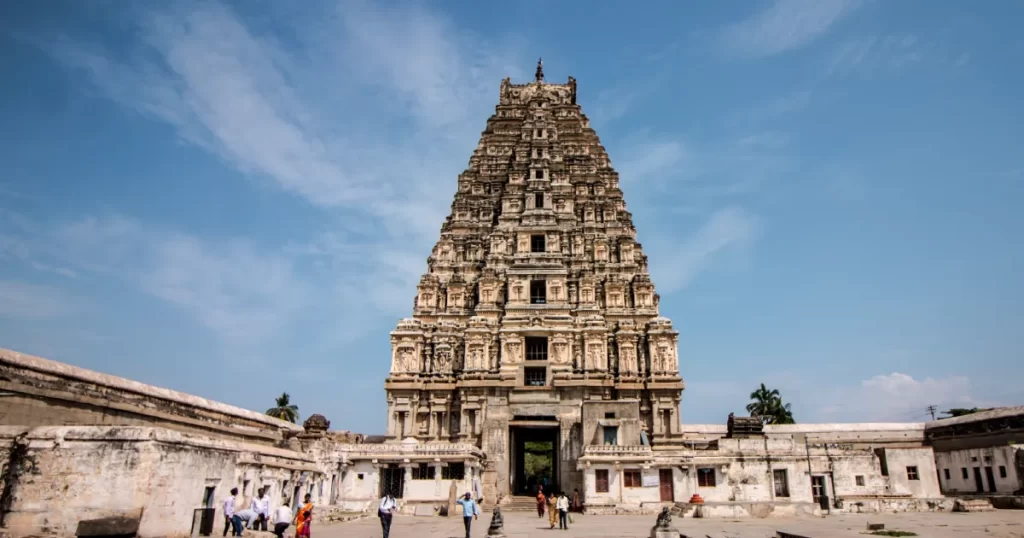
The Virupaksha Temple is a historic Hindu temple dedicated to Lord Shiva, known locally as Virupaksha, located in the town of Hampi in the Bellary district of Karnataka, India. In the race for the top 100+ most ancient temples in India, The Virupaksha Temple, Hampi, Karnataka stands at the 9th position. Here are some details about this ancient temple
- Location – The Virupaksha Temple is situated on the southern bank of the Tungabhadra River, in the heart of the UNESCO World Heritage Site of Hampi. Hampi is located in the northern part of Karnataka, approximately 353 kilometers from the state capital, Bengaluru.
- History – The temple has ancient origins and is believed to have been originally built in the 7th century AD by the rulers of the Vijayanagara Empire. It has been expanded and renovated over the centuries, with contributions from various rulers and patrons. The temple complex is a significant religious and cultural landmark in Hampi.
- Architectural Style – The Virupaksha Temple is built in the traditional Dravidian temple architecture style, characteristic of temples in southern India. The temple complex consists of a sanctum sanctorum (garbhagriha), pillared halls (mandapams), gopurams (gateway towers), and courtyards adorned with intricately carved sculptures and reliefs.
- Main Deity – The primary deity of the Virupaksha Temple is Lord Shiva, worshipped in the form of a lingam (symbol of Shiva) enshrined in the sanctum sanctorum of the temple. The lingam is believed to be one of the oldest representations of Lord Shiva in the region and is highly revered by devotees.
- Pilgrimage Destination – The Virupaksha Temple is one of the most important pilgrimage sites for Hindus in Karnataka and is visited by thousands of devotees and tourists every year. The temple is also a popular tourist attraction, attracting visitors from around the world who come to admire its architectural splendor and historical significance.
- Annual Festival – The temple celebrates an annual festival known as the Virupaksha Temple Car Festival or Hampi Utsav, which usually takes place in the month of December. The festival features colorful processions, traditional music and dance performances, cultural events, and religious rituals.
- Heritage Status – The Virupaksha Temple is a protected monument under the Archaeological Survey of India (ASI) and is recognized as a UNESCO World Heritage Site as part of the Group of Monuments at Hampi. It is managed by the Hampi Vijayanagara Archaeological Survey Project.
The Virupaksha Temple is not only a place of worship but also a symbol of Hampi’s rich heritage and cultural legacy. It stands as a testimony to the architectural and artistic achievements of the Vijayanagara Empire and continues to inspire awe and reverence among visitors to Hampi.
Lingaraj Temple, Bhubaneswar, Odisha
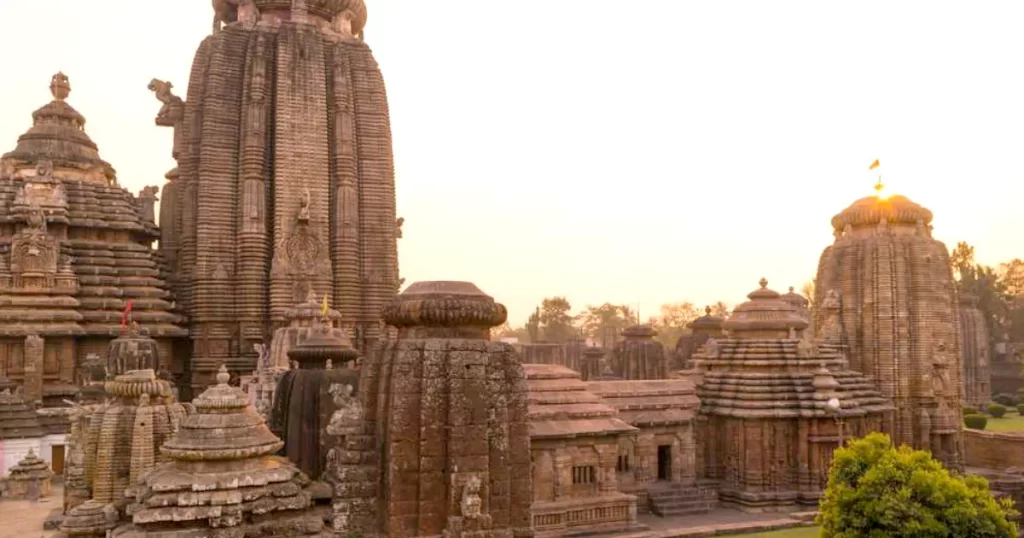
The Lingaraj Temple is a revered Hindu temple dedicated to Lord Shiva, located in the city of Bhubaneswar, the capital of Odisha, India. In the race for the top 100+ most ancient temples in India, The Lingaraj Temple, Bhubaneswar, Odisha stands at the 10th position. Here are some details about this ancient temple
- Location – The Lingaraj Temple is situated in the heart of Bhubaneswar, the capital city of Odisha. It is located in the Old Town area of Bhubaneswar, approximately 4 kilometers east of Bhubaneswar Railway Station.
- History – The temple has ancient origins dating back to the 11th century AD and is believed to have been originally built by the Somavamsi dynasty rulers. It has undergone several renovations and expansions over the centuries under different rulers, including the Ganga dynasty and the Maratha rulers.
- Architectural Style – The Lingaraj Temple is built in the traditional Kalinga style of temple architecture, characteristic of temples in Odisha. The temple complex is surrounded by high walls and consists of several structures, including the main sanctum sanctorum (garbhagriha), pillared halls (mandapams), and subsidiary shrines.
- Main Deity – The primary deity of the Lingaraj Temple is Lord Shiva, worshipped in the form of a lingam (symbol of Shiva) enshrined in the sanctum sanctorum of the temple. The lingam is believed to be a self-manifested (Swayambhu) lingam and is highly revered by devotees.
- Pilgrimage Destination – The Lingaraj Temple is one of the most important pilgrimage sites for Hindus in Odisha and is visited by thousands of devotees and tourists every year. The temple is also a popular tourist attraction, attracting visitors from around the world who come to admire its architectural splendor and historical significance.
- Festivals – The temple celebrates various festivals throughout the year, with the most significant being the Shivaratri festival, dedicated to Lord Shiva. The festival attracts thousands of devotees who gather to offer prayers, perform rituals, and participate in religious ceremonies.
- Heritage Status – The Lingaraj Temple is a protected monument under the Archaeological Survey of India (ASI) and is recognized as a UNESCO World Heritage Site as part of the Group of Monuments at Bhubaneswar. It is managed by the Lingaraj Temple Trust Board.
The Lingaraj Temple is not only a place of worship but also a symbol of Bhubaneswar’s rich cultural heritage and religious tradition. It stands as a testimony to the architectural and artistic achievements of the rulers of ancient Odisha and continues to inspire awe and reverence among visitors to Bhubaneswar.
Chennakesava Temple, Belur, Karnataka

The Chennakesava Temple is a magnificent Hindu temple dedicated to Lord Vishnu, located in the town of Belur in the Hassan district of Karnataka, India. In the race for the top 100+ most ancient temples in India, The Chennakesava Temple, Belur, Karnataka stands at the 11th position. Here are some details about this exquisite temple
- Location – The Chennakesava Temple is situated in the town of Belur, approximately 35 kilometers northeast of Hassan and 217 kilometers northwest of Bengaluru, the capital city of Karnataka.
- History – The temple was built by King Vishnuvardhana of the Hoysala Empire in the 12th century AD to commemorate his victory over the Chola dynasty. Construction of the temple began in 1117 AD and was completed over a span of several decades. It is considered one of the finest examples of Hoysala architecture.
- Architectural Style – The Chennakesava Temple is renowned for its exquisite architecture and intricate stone carvings. It is built in the Hoysala style of architecture, characterized by its star-shaped plan, intricately carved sculptures, and decorative friezes depicting mythological themes, celestial beings, and scenes from Hindu epics.
- Main Deity – The primary deity of the Chennakesava Temple is Lord Vishnu, worshipped in the form of a standing idol holding a chakra (discus) and shankha (conch) in the main sanctum sanctorum (garbhagriha) of the temple. The idol is flanked by smaller shrines dedicated to Lord Venugopala and Lord Janardhana.
- Sculptural Marvels – The temple is adorned with thousands of intricate stone sculptures and carvings, including depictions of gods, goddesses, celestial nymphs, musicians, dancers, and mythical creatures. The outer walls of the temple are embellished with elaborate friezes portraying various aspects of Hindu mythology and daily life.
- Heritage Status – The Chennakesava Temple is a protected monument under the Archaeological Survey of India (ASI) and is recognized as a UNESCO World Heritage Site as part of the Group of Monuments at Belur and Halebidu. It is considered one of the finest examples of medieval Indian architecture and sculpture.
- Visiting Hours – The temple is open to visitors every day from early morning to evening. Tourists and devotees from around the world visit the temple to admire its architectural beauty, intricate carvings, and spiritual ambiance.
The Chennakesava Temple stands as a testimony to the artistic and architectural brilliance of the Hoysala dynasty and continues to be a symbol of cultural heritage and religious devotion in Karnataka. It remains a must-visit destination for history enthusiasts, art lovers, and spiritual seekers alike.
Hoysaleswara Temple, Halebidu, Karnataka
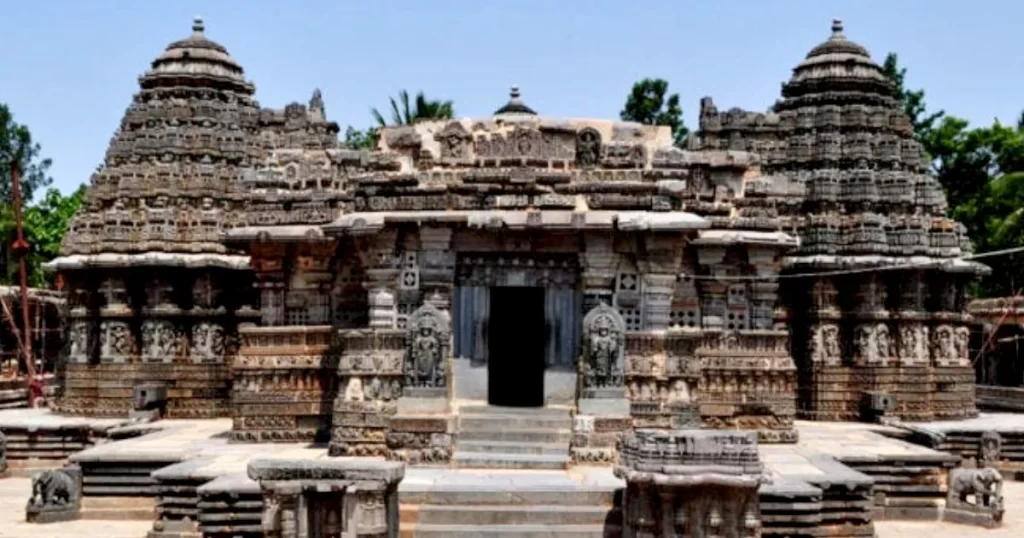
The Hoysaleswara Temple is a renowned Hindu temple dedicated to Lord Shiva, located in the town of Halebidu (also spelled Halebid), in the Hassan district of Karnataka, India. In the race for the top 100+ most ancient temples in India, The Hoysaleswara Temple, Halebidu, Karnataka stands at the 12th position. Here are some details about this magnificent temple
- Location: The Hoysaleswara Temple is situated in Halebidu, approximately 31 kilometers northwest of Hassan city and about 149 kilometers northwest of Bengaluru, the capital city of Karnataka.
- History: The temple was built during the 12th century AD by the Hoysala Empire rulers Vishnuvardhana and his son, King Veera Ballala II. Construction of the temple began in 1121 AD and continued for several decades. The temple is dedicated to Lord Shiva and is renowned for its architectural grandeur and intricate sculptures.
- Architectural Style: The Hoysaleswara Temple is an outstanding example of Hoysala architecture, known for its intricate stone carvings, sculptural friezes, and elaborate decorative details. The temple complex consists of a main shrine dedicated to Lord Shiva, along with smaller shrines dedicated to other deities.
- Main Deity: The primary deity of the Hoysaleswara Temple is Lord Shiva, worshipped in the form of a lingam (symbol of Shiva) enshrined in the main sanctum sanctorum (garbhagriha) of the temple. The lingam is adorned with offerings and worshipped by devotees who visit the temple.
- Sculptural Marvels: The temple is adorned with thousands of intricately carved sculptures and reliefs depicting various Hindu deities, mythological scenes, celestial beings, and animals. The outer walls of the temple are adorned with friezes portraying episodes from the Ramayana, Mahabharata, and Puranas.
- Heritage Status: The Hoysaleswara Temple is a protected monument under the Archaeological Survey of India (ASI) and is recognized as a UNESCO World Heritage Site as part of the Group of Monuments at Belur and Halebidu. It is considered one of the finest examples of medieval Indian architecture and sculpture.
- Visiting Hours: The temple is open to visitors every day from early morning to evening. Tourists and devotees from around the world visit the temple to admire its architectural beauty, intricate carvings, and spiritual ambiance.
The Hoysaleswara Temple is a testament to the artistic and architectural brilliance of the Hoysala dynasty and continues to be a symbol of cultural heritage and religious devotion in Karnataka. It remains a must-visit destination for history enthusiasts, art lovers, and spiritual seekers alike.
Ramanathaswamy Temple, Rameswaram, Tamil Nadu
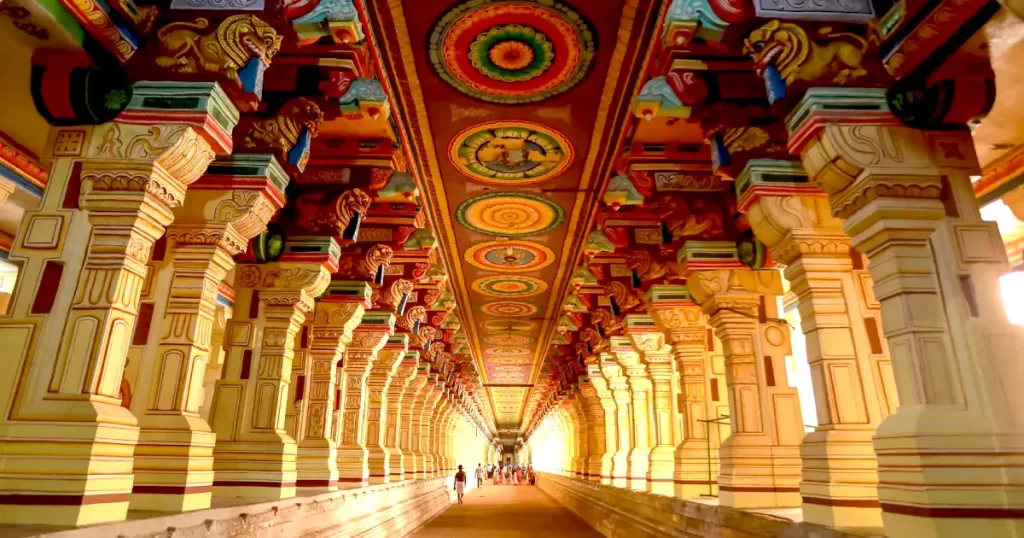
The Ramanathaswamy Temple is a renowned Hindu temple dedicated to Lord Shiva, known as Ramanathaswamy, located in the town of Rameswaram in the Ramanathapuram district of Tamil Nadu, India. In the race for the top 100+ most ancient temples in India, The Ramanathaswamy Temple, Rameswaram, Tamil Nadu stands at the 13th position. Here are some details about this sacred temple
- Location The Ramanathaswamy Temple is situated on Rameswaram Island, which is located in the Gulf of Mannar, off the southeastern coast of Tamil Nadu. Rameswaram is connected to the mainland by the Pamban Bridge.
- History The temple has ancient origins dating back to the Ramayana period and is closely associated with the legend of Lord Rama and his divine consort Sita. According to mythology, Lord Rama built a lingam (symbol of Shiva) at Rameswaram and worshipped Lord Shiva here to absolve himself of the sin of killing Ravana, a Brahmin.
- Architectural Style The Ramanathaswamy Temple is an architectural masterpiece and is renowned for its grandeur and intricate sculptures. The temple complex comprises several mandapams (halls), gopurams (gateway towers), and shrines dedicated to various deities. The corridors of the temple are adorned with thousands of intricately carved pillars.
- Main Deity The primary deity of the Ramanathaswamy Temple is Lord Shiva, worshipped in the form of a lingam enshrined in the main sanctum sanctorum (garbhagriha) of the temple. The lingam is believed to have been consecrated by Lord Rama himself and is highly revered by devotees.
- Pilgrimage Destination The Ramanathaswamy Temple is one of the holiest pilgrimage sites for Hindus and is considered one of the Char Dham pilgrimage destinations in India. It attracts thousands of devotees and tourists every year, especially during festivals and auspicious occasions.
- Rituals and Festivals The temple celebrates various festivals throughout the year, with the most significant being the Maha Shivaratri festival, dedicated to Lord Shiva. Other important festivals include Thaipusam, Navaratri, and Arudra Darshanam. Special rituals, processions, and religious ceremonies are conducted during these festivals.
- Bathing Ghats The temple complex also includes 22 sacred wells or theerthams (bathing ghats), where devotees take ritual baths to purify themselves before offering prayers to Lord Shiva. Each theertham is believed to have its own unique significance and benefits.
- Heritage Status The Ramanathaswamy Temple is a protected monument under the Archaeological Survey of India (ASI) and is recognized as a significant religious and cultural heritage site in India.
The Ramanathaswamy Temple holds immense spiritual significance for Hindus and is revered as one of the most sacred pilgrimage destinations in India. It continues to be a symbol of faith, devotion, and cultural heritage, attracting pilgrims and tourists from around the world.
Shore Temple, Mahabalipuram, Tamil Nadu
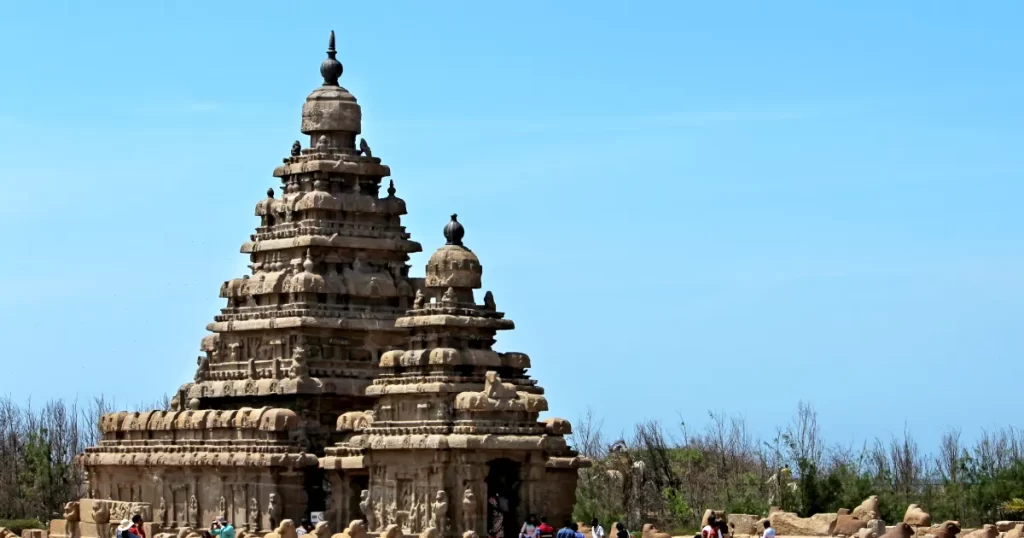
The Shore Temple is a magnificent Hindu temple complex dedicated to Lord Shiva, located in the coastal town of Mahabalipuram (also known as Mamallapuram) in the Kanchipuram district of Tamil Nadu, India. In the race for the top 100+ most ancient temples in India, The Shore Temple, Mahabalipuram, Tamil Nadu stands at the 14th position. Here are some details about this historic temple
- Location – The Shore Temple is situated on the shores of the Bay of Bengal, in the town of Mahabalipuram, approximately 58 kilometers south of Chennai, the capital city of Tamil Nadu.
- History – The Shore Temple was built during the 7th century AD by the Pallava dynasty rulers, who were prolific builders and patrons of art and architecture. The temple is believed to have been constructed under the patronage of King Narasimhavarman II (also known as Rajasimha), who played a significant role in the development of Mahabalipuram as a center of art and culture.
- Architectural Style – The Shore Temple is an architectural marvel and is renowned for its Dravidian temple architecture style, characteristic of temples in southern India. The temple complex consists of three shrines, two dedicated to Lord Shiva and one to Lord Vishnu, along with various mandapams (halls) and pavilions.
- Main Deities – The primary deities worshipped in the Shore Temple are Lord Shiva and Lord Vishnu. The main shrine dedicated to Lord Shiva houses a large lingam (symbol of Shiva) enshrined in the sanctum sanctorum (garbhagriha) of the temple. The other shrines house idols of Lord Vishnu in various forms.
- Sculptural Marvels – The Shore Temple is adorned with exquisite stone carvings and sculptures depicting various gods, goddesses, celestial beings, and mythical creatures. The temple walls are adorned with intricate reliefs portraying scenes from Hindu mythology, including episodes from the Ramayana and Mahabharata.
- Heritage Status – The Shore Temple is a protected monument under the Archaeological Survey of India (ASI) and is recognized as a UNESCO World Heritage Site as part of the Group of Monuments at Mahabalipuram. It is considered one of the finest examples of Pallava architecture and sculpture.
- Visiting Hours – The Shore Temple is open to visitors every day from early morning to evening. Tourists and devotees from around the world visit the temple to admire its architectural beauty, historical significance, and serene coastal surroundings.
The Shore Temple stands as a testament to the rich cultural heritage and architectural legacy of the Pallava dynasty. It remains a popular tourist attraction and pilgrimage destination, drawing visitors with its timeless beauty, spiritual ambiance, and historical charm.
Brihadeshwara Temple, Gudimallam, Andhra Pradesh

The Brihadeshwara Temple, also known as the Rajarajeswaram Temple, is a famous Hindu temple dedicated to Lord Shiva, located in the village of Gudimallam in the Chittoor district of Andhra Pradesh, India. It is often confused with the Brihadeeswarar Temple, which is located in Thanjavur, Tamil Nadu, and is dedicated to the same deity, Lord Shiva.
In the race for the top 100+ most ancient temples in India, The Brihadeshwara Temple, Gudimallam, Andhra Pradesh stands at the 15th position. Here are some details about the Brihadeshwara Temple in Gudimallam
- Location – The Brihadeshwara Temple is situated in the village of Gudimallam, which is located near the town of Renigunta in the Chittoor district of Andhra Pradesh, approximately 25 kilometers from Tirupati.
- History – The Brihadeshwara Temple in Gudimallam is believed to be one of the oldest temples dedicated to Lord Shiva in South India. It dates back to the early Chola period, around the 9th century AD. The temple is known for its historical significance and architectural beauty.
- Architectural Style – The Brihadeshwara Temple in Gudimallam is built in the Dravidian style of temple architecture, characterized by its towering gopurams (gateway towers), pillared halls, and intricate stone carvings. The temple has a simple yet elegant design and is surrounded by a spacious courtyard.
- Main Deity – The primary deity of the Brihadeshwara Temple is Lord Shiva, worshipped in the form of a lingam (symbol of Shiva) enshrined in the main sanctum sanctorum (garbhagriha) of the temple. The lingam is adorned with offerings and worshipped by devotees who visit the temple.
- Significance – The Brihadeshwara Temple in Gudimallam is considered a sacred pilgrimage site for devotees of Lord Shiva. It is believed to possess immense spiritual energy and is visited by devotees seeking blessings, fulfillment of desires, and liberation from worldly sufferings.
- Festivals – The temple celebrates various festivals throughout the year, with the most significant being the Maha Shivaratri festival, dedicated to Lord Shiva. The festival attracts thousands of devotees who gather to offer prayers, perform rituals, and participate in religious ceremonies.
- Accessibility – The Brihadeshwara Temple in Gudimallam is easily accessible by road from the nearby town of Renigunta. It is located approximately 25 kilometers from Tirupati, which is well-connected by road and rail networks.
While the Brihadeshwara Temple in Gudimallam may not be as famous as its counterpart in Thanjavur, it holds immense religious and historical significance for devotees of Lord Shiva and is worth visiting for its serene ambiance and architectural beauty.
Importance of Temples in Indian Culture
Temples hold immense importance in Indian culture, serving as the focal points of religious, social, and cultural life. Here are some key reasons why temples are significant in Indian culture
- Spiritual Centers – Temples are places of worship where devotees gather to offer prayers, perform rituals, and seek blessings from the deities. They provide a sacred space for spiritual reflection, meditation, and communion with the divine.
- Preservation of Tradition – Temples play a crucial role in preserving and perpetuating religious traditions, rituals, and scriptures handed down through generations. They serve as repositories of ancient knowledge and wisdom, safeguarding the cultural heritage of the community.
- Community Gathering – Temples serve as community centers where people from diverse backgrounds come together to celebrate festivals, conduct religious ceremonies, and participate in cultural events. They foster a sense of unity, solidarity, and social cohesion among devotees.
- Education and Learning – Temples are not just places of worship but also centers of learning and scholarship. Many temples have associated schools, libraries, and scripture study groups where devotees can learn about religious texts, philosophy, and spiritual practices.
- Philanthropy and Service – Temples engage in various charitable activities such as providing food, shelter, healthcare, and education to the needy. They promote the values of compassion, generosity, and social responsibility, inspiring devotees to serve the community.
- Symbol of Identity – Temples are symbols of cultural identity and pride for communities across India. They reflect the architectural, artistic, and spiritual achievements of ancient civilizations and serve as iconic landmarks that define the cultural landscape of the region.
- Pilgrimage Destinations – Many temples in India are revered as sacred pilgrimage sites, attracting millions of devotees and tourists each year. Pilgrimage to these holy places is considered a spiritual journey that purifies the soul and strengthens one’s faith.
- Economic Impact – Temples contribute significantly to the local economy by generating employment, stimulating tourism, and supporting small businesses. They are important drivers of economic development in rural and urban areas, providing livelihoods to artisans, priests, and service providers.
- Environmental Conservation: Temples often have associated natural surroundings such as forests, rivers, and mountains, which are considered sacred and protected. They promote environmental conservation and sustainable practices to preserve the ecological balance.
In summary, temples are integral to Indian culture, serving as sacred spaces for worship, learning, and community engagement. They embody the spiritual aspirations, cultural values, and social traditions of the Indian civilization, fostering harmony, peace, and well-being in society.
Architectural Specifications of Indian Temples
Indian temples exhibit a diverse range of architectural styles, each with its unique features and characteristics. Here are some common architectural specifications of Indian temples
- Layout and Design – Indian temples typically follow a prescribed architectural plan known as Vastu Shastra or Agama Shastra, which governs the temple’s layout, orientation, and design. The layout often consists of a sanctum sanctorum (garbhagriha), surrounded by a circumambulatory path (pradakshina patha), and various ancillary structures such as mandapams (pillared halls), gopurams (gateway towers), and vimanas (temple towers).
- Materials – Temples are constructed using locally available materials such as stone, brick, wood, and laterite. Stone temples are particularly common in South India, where granite and sandstone are abundant, while brick and wood temples are more prevalent in North India.
- Sculpture and Carvings – Indian temples are renowned for their intricate stone carvings and sculptures depicting gods, goddesses, celestial beings, mythical creatures, and scenes from Hindu mythology. These carvings adorn the walls, pillars, doorways, and ceilings of the temple, adding to its aesthetic beauty and spiritual significance.
- Temple Towers (Vimanas) – One of the most distinctive features of Indian temples is the towering vimanas that rise above the sanctum sanctorum. These elaborately sculpted towers, also known as shikharas or gopurams, are often adorned with decorative motifs, miniature shrines, and kalashas (pot-like structures) symbolizing divine energy.
- Pillared Halls (Mandapams) – Temples typically include pillared halls or mandapams used for various purposes such as assembly, prayer, and performance of rituals. These halls are characterized by rows of intricately carved pillars supporting the roof and are often adorned with sculptures depicting gods, goddesses, and celestial beings.
- Entrance Gateways (Gopurams) – Indian temples are often embellished with ornate entrance gateways or gopurams, which serve as monumental portals leading into the temple complex. Gopurams are typically multi-storied structures adorned with sculptural reliefs, friezes, and figurative decorations depicting mythological narratives and religious themes.
- Water Features – Many Indian temples incorporate water features such as tanks, ponds, and stepwells (pushkarinis) within their precincts. These water bodies serve both practical and symbolic purposes, providing water for ritual purification and aesthetic beauty while also symbolizing spiritual purity and rejuvenation.
- Symbolism and Iconography – The architectural elements of Indian temples are rich in symbolism and iconography, with each component carrying profound religious and philosophical meanings. From the orientation of the temple to the placement of deities and the arrangement of sculptures, every detail is imbued with spiritual significance and cosmic symbolism.
Overall, the architectural specifications of Indian temples reflect the profound spiritual, cultural, and artistic legacy of the Indian civilization, showcasing the ingenuity, creativity, and devotion of its builders and artisans.

